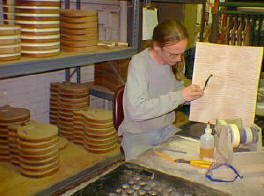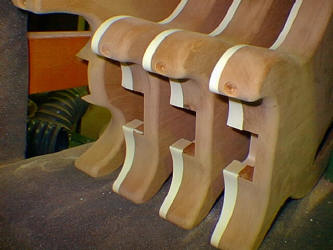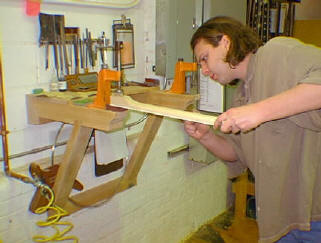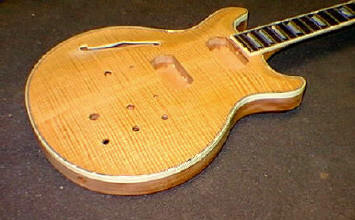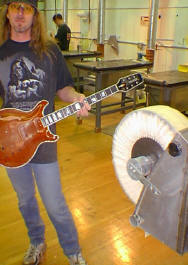| Home > All Guitars > Hamer Guitars > Hamer Factory Tour |
Hamer Factory Tour |
|||||||||
|
April 2 1998 Hamer is over 27 years old and instead of getting bigger they have actually concentrated on becoming smaller. Hamer employs only 10 people, all of them Luthiers When I do a factory tour of an old guitar company like Hamer, I generally expect to see a lot of cost cutting, and short cuts that have been instituted over the years by the corporate bean counters. I was pretty surprised to see that in the case of Hamer that was absolutely not the case. Wood Department
Rejecting Wood When Hamer buys wood from the mills they pay a 15% surcharge for just the right to be able to pick the better looking, straighter grained, lighter weight wood from the rest of the shipment. (expensive) They keep about 30% and return up to 70%. Hamer must bear the cost of shipping the complete palettes from the mill (very expensive) Then Hamer must bear the expense of shipping all the rejected wood back this is extremely expensive when you are rejecting 70% of the wood like Hamer does. The above represents about a 40% to 50% increase in the cost of your wood. It becomes very hard to compete with other companies on a price level if you reject as much as Hamer does. (When I buy wood for my guitars I can't afford to reject this much so I generally go and handpick each piece myself) I find it usually costs me 20% more to do this. This is impossible for a large company to do. When Paul Reed Smith started he would drive all over to different mills and wood suppliers and buy wood. When he built his first guitars he only used hand picked billets, He also used the hand picked wood on most of the Signature Series guitars released in 1989 through 1991 This is what small builders like Jeff Terwilliger, Rick Turner & Myself are doing today. Hamer is probably the only company that I know of that does it the expensive way by rejecting the wood. I know that any manufacturer citing these extremely high percentages of rejection could be just saying that to make themselves look good. So when I was walking around the factory I kept my eyes open for any evidence to either support or disprove the claim. After I had been at the factory several hours I surmised that Jol was definitely not kidding me about Hamer's rejection process. The 3 reasons below are why I am sure that the percentages quoted were factual. 1. I observed a very large pile of Korina
headed for the dumpster. Above I have pointed out reasons why rejection
is expensive To actually do this, to go through all of the above motions for rejecting the wood. It requires a tremendous amount of TIME. This tremendous amount of time must be dealt with by a very highly trained, usually very highly paid individual who knows exactly what he is doing. This is the real backbreaking additional cost for selecting wood. This Job requires concentration and has to be done as soon as the wood arrives so that they can return the chaff. Everything is hand carved at Hamer!!!!!
Here the artisan has just finished hand carving the inner tone chamber and
"F" hole. He then proceeds to hand bind the "F" hole with premium Ivoroid. I was
looking around wondering where the automated duplicarver was for carving the
arch tops. 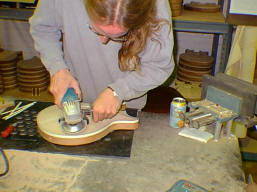
Attention To Minuscule Details
Hand Made Necks
Here a very capable woodworker is hand shaping the exclusive
3 piece stress relieved Hamer neck. Fingerboards
The Limited Edition Ultimate Artist Model.
Finishing Department All 10 Hamer employees are all veterans of the original Chicago plant. This is Hamer Ltd Edition Ultimate Artist Serial # 1 Hamer does their finishing the original tasteful vintage way. First there are 5 coats of clear applied to the sealed wood. The finish is hand sanded rubbed down to approximately 2 coats. Then the color is applied and then the final coats of clear. Hamer finishes take on a three dimensional appearance because the color is actually floated between coats of clear lacquer. Hamer is using an exclusive hybrid nitrocellulose lacquer and urethane combination. This ultra thin highly tone enhancing finish is one of the reasons that I believe Hamer is taking a back seat to JET, & PRS in the sales department. The downside to doing this finish is that it is much harder to get the grain enhanced or the cosmetics of the wood to pop out. The aforementioned other builders use a completely different method. Their method is to first stain the wood a dark color and then sand some of it off so that in effect the grain is enhanced by pre staining. After the grain is enhanced the color is applied and then the clear coats. I don't know which way is better, I personally love the way the JET grain leaps off the guitar right into your face. I also see Jol's point about sticking to the more tasteful traditional Hamer method. Many of my "Tone Freak" customers insist that I do not use any grain enhancers on the custom guitars I build for them. We discussed this situation for over an hour and I feel that Hamer will probably make this style available in the very near future. Perhaps as an option. I believe they are now experimenting with the double stain process as this story is being written. I have been doing this process in my shop for several years. See the Quicksilver & Pearlcaster Guitars As of 06/03/98 Hamer Corporation and Ed Roman have struck a deal for an exclusive run of Double Stained, Scred Finish Guitars. These guitars will employ the 3 dimensional Hamer Finish and the two dimensional PRS Style Finish. Of course the original finish style will also be available, Call me for details & info. 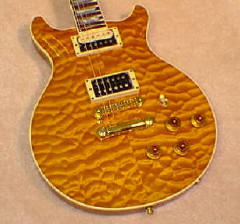
Now Ed Roman will be able to offer Hamer Guitars with finishes
that rival PRS |
